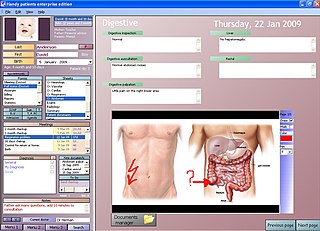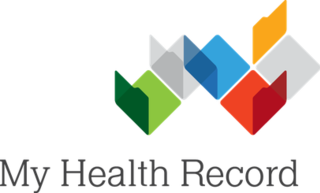Related Research Articles

Health informatics is the study and implementation of computer structures and algorithms to improve communication, understanding, and management of medical information. It can be viewed as a branch of engineering and applied science.
Health Level Seven, abbreviated to HL7, is a range of global standards for the transfer of clinical and administrative health data between applications with the aim to improve patient outcomes and health system performance. The HL7 standards focus on the application layer, which is "layer 7" in the Open Systems Interconnection model. The standards are produced by Health Level Seven International, an international standards organization, and are adopted by other standards issuing bodies such as American National Standards Institute and International Organization for Standardization. There are a range of primary standards that are commonly used across the industry, as well as secondary standards which are less frequently adopted.

An electronic health record (EHR) is the systematized collection of patient and population electronically stored health information in a digital format. These records can be shared across different health care settings. Records are shared through network-connected, enterprise-wide information systems or other information networks and exchanges. EHRs may include a range of data, including demographics, medical history, medication and allergies, immunization status, laboratory test results, radiology images, vital signs, personal statistics like age and weight, and billing information.

Logical Observation Identifiers Names and Codes (LOINC) is a database and universal standard for identifying medical laboratory observations. First developed in 1994, it was created and is maintained by the Regenstrief Institute, a US nonprofit medical research organization. LOINC was created in response to the demand for an electronic clinical care and management database and is publicly available at no cost.
Health information exchange (HIE) is the mobilization of health care information electronically across organizations within a region, community or hospital system. Participants in data exchange are called in the aggregate Health Information Networks (HIN). In practice, the term HIE may also refer to the health information organization (HIO) that facilitates the exchange.
The Clinical Data Interchange Standards Consortium (CDISC) is a standards developing organization (SDO) dealing with medical research data linked with healthcare,made to enable information system interoperability and to improve medical research and related areas of healthcare. The standards support medical research from protocol through analysis and reporting of results and have been shown to decrease resources needed by 60% overall and 70–90% in the start-up stages when they are implemented at the beginning of the research process. Since December 2016, CDISC standards are mandatory for submission to US FDA.
The HL7 Clinical Document Architecture (CDA) is an XML-based markup standard intended to specify the encoding, structure and semantics of clinical documents for exchange. In November 2000, HL7 published Release 1.0. The organization published Release 2.0 with its "2005 Normative Edition".
Health information management (HIM) is information management applied to health and health care. It is the practice of analyzing and protecting digital and traditional medical information vital to providing quality patient care. With the widespread computerization of health records, traditional (paper-based) records are being replaced with electronic health records (EHRs). The tools of health informatics and health information technology are continually improving to bring greater efficiency to information management in the health care sector.

The Veterans Health Information Systems and Technology Architecture (VISTA) is the system of record for the clinical, administrative and financial operations of the Veterans Health Administration VISTA consists of over 180 clinical, financial, and administrative applications integrated within a single shared lifelong database (figure 1).
popHealth is an open-source reference implementation software tool that automates population health reporting.
AHLTA is a global Electronic Health Record (EHR) system used by U.S. Department of Defense (DoD). It was implemented at Army, Navy and Air Force Military Treatment Facilities (MTF) around the world between January 2003 and January 2006. It is a services-wide medical and dental information management system. What made AHLTA unique was its implementation date, its Central Data Repository, its use in operational medicine and its global implementation. There is nothing like it in the private sector.
Radiation Exposure Monitoring (REM) is a framework developed by Integrating the Healthcare Enterprise (IHE), for utilizing existing technical standards, such as DICOM, to provide information about the dose delivered to patients in radiology procedures, in an interoperable format.
Medical device connectivity is the establishment and maintenance of a connection through which data is transferred between a medical device, such as a patient monitor, and an information system. The term is used interchangeably with biomedical device connectivity or biomedical device integration. By eliminating the need for manual data entry, potential benefits include faster and more frequent data updates, diminished human error, and improved workflow efficiency.
A Vendor Neutral Archive (VNA) is a medical imaging technology in which images and documents are stored (archived) in a standard format with a standard interface, such that they can be accessed in a vendor-neutral manner by other systems.

Medical image sharing is the electronic exchange of medical images between hospitals, physicians and patients. Rather than using traditional media, such as a CD or DVD, and either shipping it out or having patients carry it with them, technology now allows for the sharing of these images using the cloud. The primary format for images is DICOM. Typically, non-image data such as reports may be attached in standard formats like PDF during the sending process. Additionally, there are standards in the industry, such as IHE Cross Enterprise Document Sharing for Imaging (XDS-I), for managing the sharing of documents between healthcare enterprises. A typical architecture involved in setup is a locally installed server, which sits behind the firewall, allowing secure transmissions with outside facilities. In 2009, the Radiological Society of North America launched the "Image Share" project, with the goal of giving patients control of their imaging histories by allowing them to manage these records as they would online banking or shopping.

Integrating the Healthcare Enterprise (IHE) is a non-profit organization based in the US state of Illinois. It sponsors an initiative by the healthcare industry to improve the way computer systems share information. IHE was established in 1998 by a consortium of radiologists and information technology (IT) experts.
Health Level Seven International (HL7) is a non-profit ANSI-accredited standards development organization that develops standards that provide for global health data interoperability.
Federal and state governments, insurance companies and other large medical institutions are heavily promoting the adoption of electronic health records. The US Congress included a formula of both incentives and penalties for EMR/EHR adoption versus continued use of paper records as part of the Health Information Technology for Economic and Clinical Health (HITECH) Act, enacted as part of the, American Recovery and Reinvestment Act of 2009.

My Health Record (MHR) is the national digital health record platform for Australia, and is managed by the Australian Digital Health Agency. It was originally established as the Personally Controlled Electronic Health Record (PCEHR), a shared electronic health summary set up by the Australian government with implementation overseen by the National Electronic Health Transition Authority (NEHTA). The purpose of the MHR is to provide a secure electronic summary of people's medical history which will eventually include information such as current medications, adverse drug reactions, allergies and immunisation history in an easily accessible format. This MHR is stored in a network of connected systems with the ability to improve the sharing of information amongst health care providers to improve patient outcomes no matter where in Australia a patient presents for treatment. PCEHR was an opt-in system with a unique individual healthcare identifier (IHI) being assigned to participants and the option of masking and limiting information available for viewing controlled by the patient or a nominated representative; MHR uses an opt-out system.
Clinical data standards are used to store and communicate information related to healthcare so that its meaning is unambiguous. They are used in clinical practice, in activity analysis and finding, and in research and development.
References
- ↑ Trotter, Fred; Uhlman, David (2011). Hacking Healthcare: A Guide to Standards, Workflows, and Meaningful Use. O'Reilly Media, Inc. p. 193. ISBN 9781449318802.
- 1 2 3 Sinha, Pradeep K.; et al. (2012). Electronic Health Record: Standards, Coding Systems, Frameworks, and Infrastructures. John Wiley & Son. p. 180. ISBN 9781118479643.
- ↑ "IHE Cross Enterprise Document Sharing (XDS) Profile". www.research.ibm.com/. IBM. Retrieved 22 September 2014.
- ↑ Liu, Yu; Wang, Jihong (2010-11-05). PACS and Digital Medicine: Essential Principles and Modern Practice. CRC Press. ISBN 978-1-4200-8366-8.
- ↑ Branstetter, Barton F. (2009). Practical Imaging Informatics: Foundations and Applications for PACS Professionals . Springer Science & Business Media. pp. 142–143. ISBN 9781441904850.